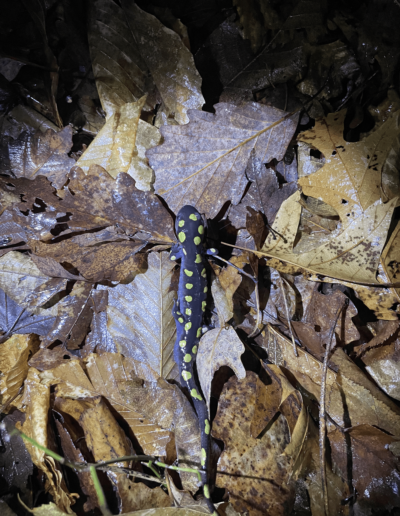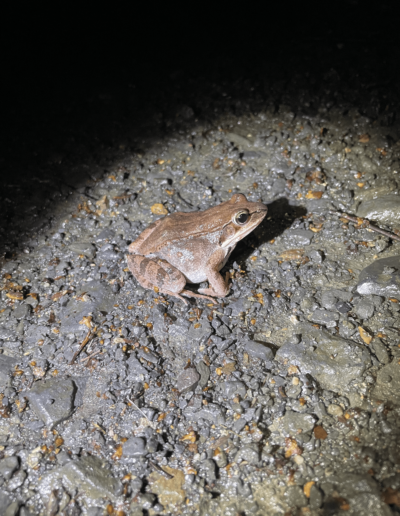Amphibians and Their Great Trek

On a warm day in the late winter, with rain pouring down, the amphibians of Pennsylvania stir from their winter slumbers. Frogs, salamanders, and more rustle from beneath the freshly thawed earth and begin their courageous migration. From their woodland habitats, these amphibians trek across rocky terrain, fallen trees, and roadways to reach their vernal pools. These pools serve as their breeding sites and are imperative to support the populations of many amphibians. When the weather aligned and the timing was right, the Feather and Fern Wildscapes team set out to see this amazing migration!
What is a Vernal Pool?
To find the salamanders and frogs, we had to know where the vernal pools are nearby. By viewing maps and considering the geology, we are able to identify where some may be located! Our area in central Pennsylvania often has limestone bedrock. Overtime, groundwater dissolves this limestone and creates small depressions in the ground (which is why PA has sinkholes, eeek!). In natural areas, these depressions can collect water and turn into vernal pools!1 These vernal pools are considered a wetland habitat. They are typically only fed by rainwater and snow melt. During the wet seasons, the depth of water can vary with some pools accumulating six inches of water and others closer to four feet. Then, these pools dry up in the summer – but don’t worry, local flora and fauna are accustomed to this! With the differences in shape, location, and water depth, each vernal pool can feel like its own community. That is what we discovered during our outings this winter!
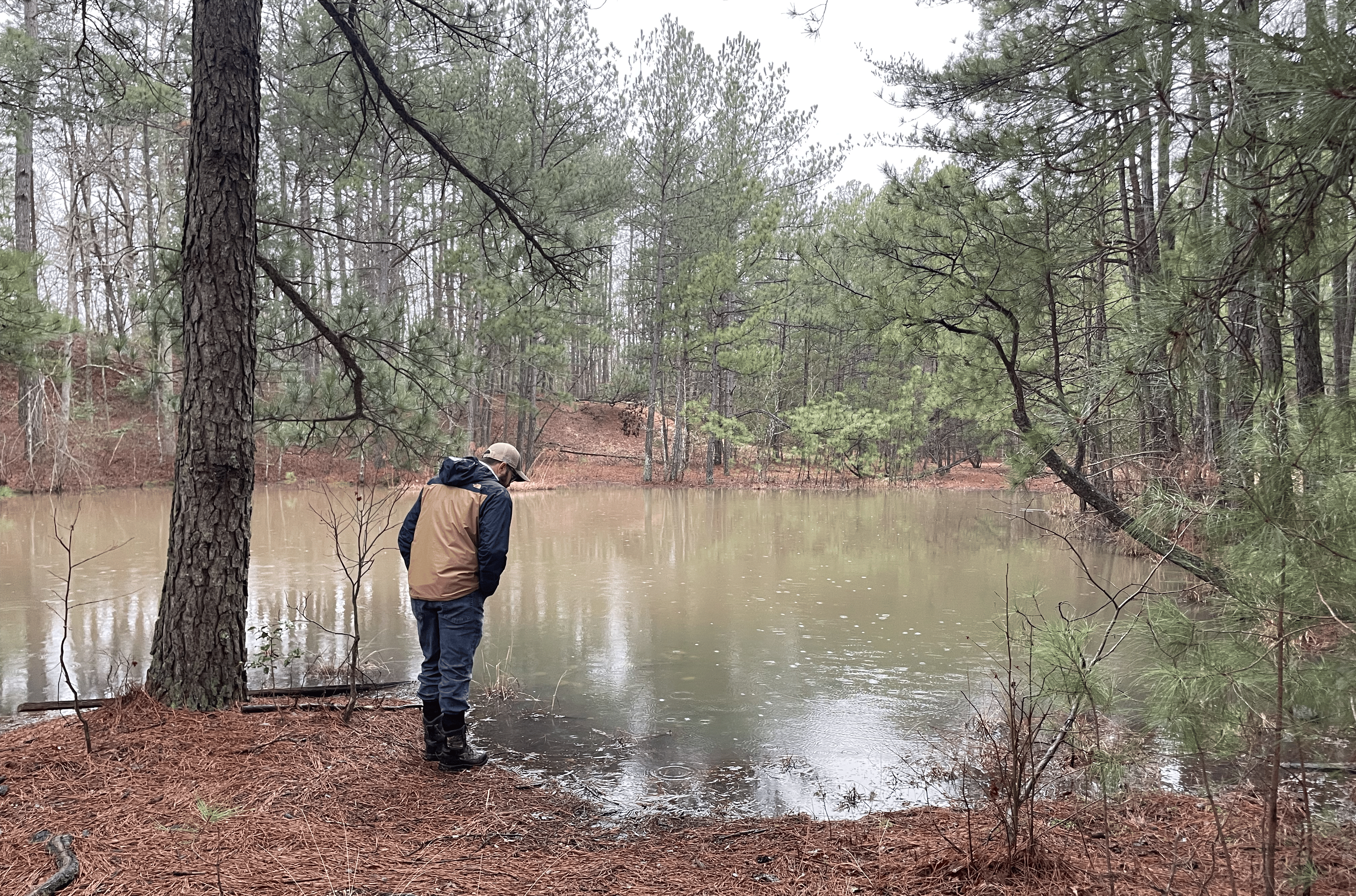
As the winter season came to end, we patiently waited for a rainy night with temperatures between 50 and 60 degrees. When the weather aligned for the first time, the F&F Wildscapes team pulled on their muck boots and gathered at the trailhead to hike to the pools. We reached the first pool and observed ice still covering most of it. The only sound we heard was the pattering of rain hitting the leaf litter. This meant our frogs had not yet emerged and migrated to the pools. With these indicators, we knew we had one very special species to look out for, the Jefferson salamander (Ambystoma jeffersonianum).
Amphibian Sighting!
The Jeffersons typically emerge earlier than other amphibians and are the first to arrive at the vernal pools! With their grayish coloration and faint blue speckling along their sides, this species can easily blend in with the mud and leaf litter around the pools.2 We spotted our first salamander in shallow water at the edge of the pool and then quickly saw more as our eyes grew accustomed to the landscape. Under leaf litter in the water, we found Jefferson salamanders grouped together. This gave us a fun opportunity to use the term for a group of salamanders – a congress! So, of course we had to announce every congress of Jeffersons we found to one another! We left these vernal pools excited to return on the next warm, rainy night.

Soon after our first night exploring these pools, the weather conditions were right again for another hike to view the amphibian migration! It was not long on our hike that we came across our first salamander! Crossing the trail in front of us, was a vibrant and determined spotted salamander (Ambystoma maculatum). We quietly watched as the salamander crawled across the moss and leaves, guided by instinct, to a vernal pool.
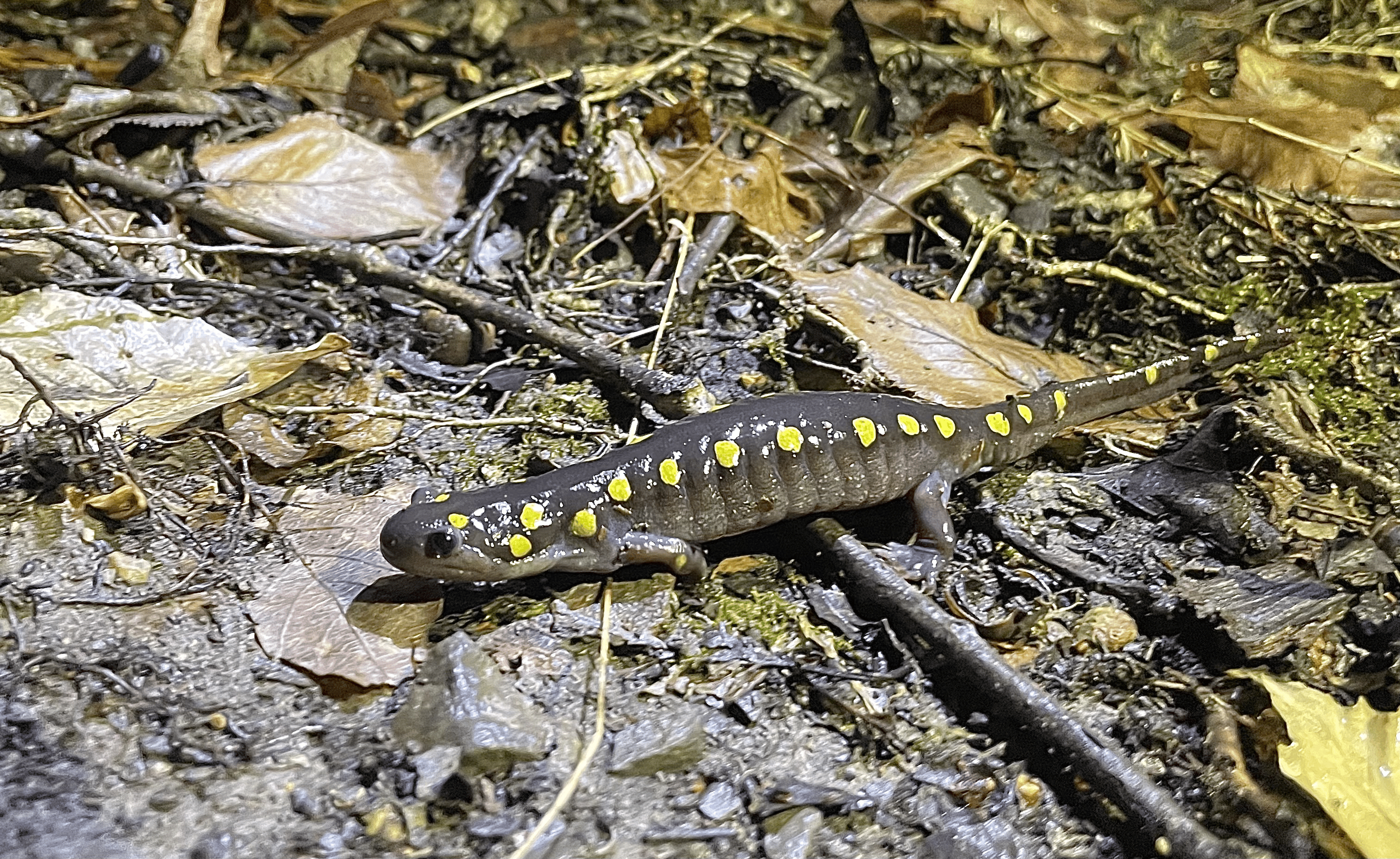
As we continued, more and more spotted salamanders appeared as we got closer to the pools. The spotted salamander is distinct and identifiable because of the two rows of brilliant, yellow spots that run from its head to its tail. They are the most common species of mole salamanders in Pennsylvania (genus Ambystoma).2 Along with salamanders crossing the trail, we found wood frogs (Rana sylvatica) hopping towards the pools as well. As we reached our destination, the chorus of wood frog calls filled the forest. On this warm night, a week later than our first outing, we saw that most of the ice had melted in the pools. With these warming conditions, the activity in the vernal pools was astounding!
An Amazing World!
We all crouched on the edge of the first vernal pool and watched as Jefferson and spotted salamanders crawled past us and entered their vernal pools. It was amazing to observe these creatures touch the water for the first time in a year, some for the first time ever! Our group lost count of the salamanders trekking across the land and swimming through the water. Shining our flashlights across the surface of the pool, we could see the eyes of dozens of wood frogs gleaming back at us. It truly felt like we had stepped off the trail and entered another world!
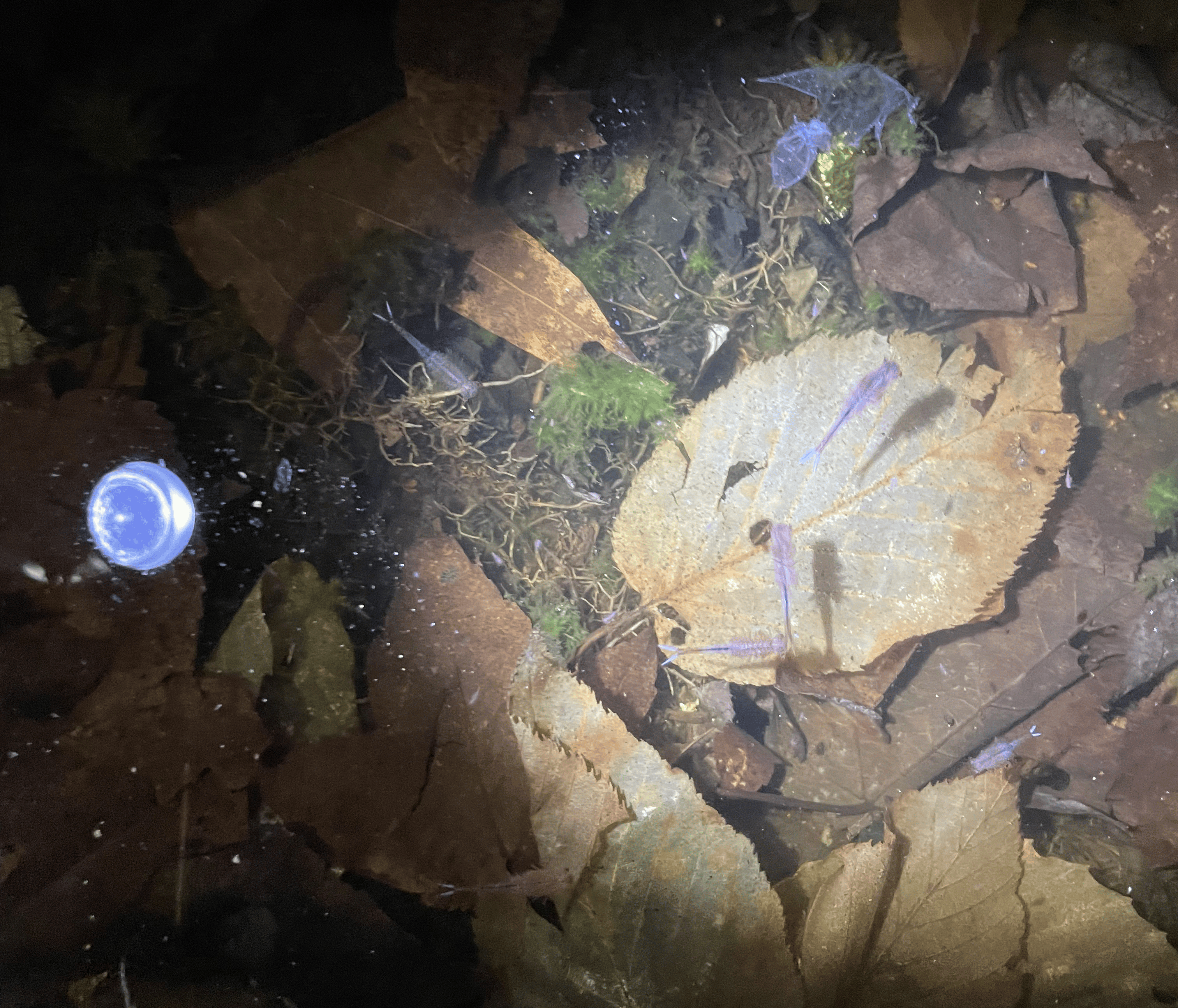
Appreciate and Protect Habitats
We left the vernal pools in awe of nature and the cycles of life functioning all around us!
Over the next couple of weeks, these salamanders will mate and the females will lay eggs throughout these vernal pools. These egg masses will look like translucent, gelatinous blobs floating in the water.5 Each of the egg starts out looking like a black dot in the jelly layer and over a few weeks, the eggs develop into the larva stage before hatching. With the migration we witnessed this late winter, these vernal pools will be bustling with activity all spring!
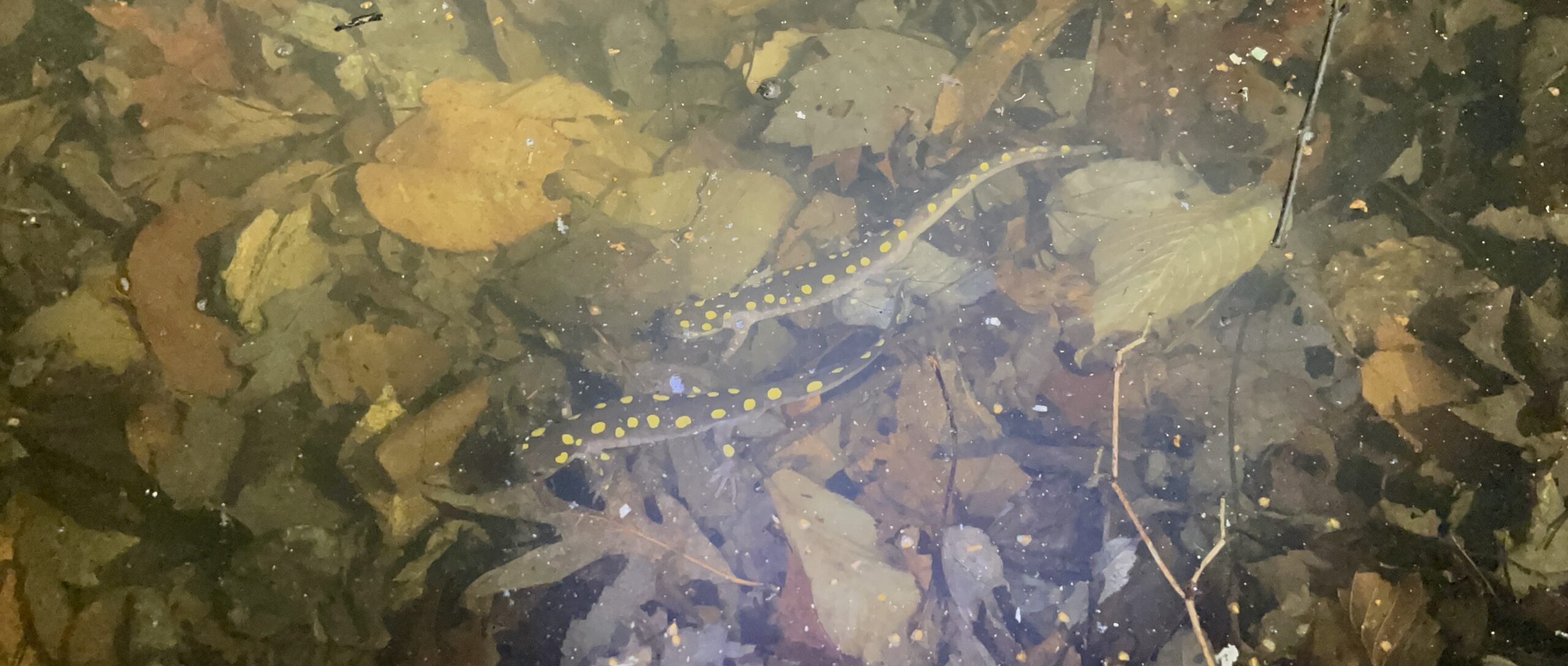
Vernal pools are a unique and sensitive habitat. They are increasingly threatened by human activity, primarily development. With these pools being the sole breeding locations for many amphibians, we must protect them in order to protect countless animal species. If you find a vernal pool on your property, be sure to avoid using herbicide and pesticide treatments nearby, and limit your use of the area to avoid disturbing this habitat. You can register a vernal pool with the Pennsylvania Natural Heritage Program to provide valuable information to the scientists who work hard to protect these wetland habitats.

We thank you for following along with Feather and Fern Wildscapes on this adventure! We’ll continue to use this blogspace to write about all things interesting and fun in the plant world. If you have questions about a certain plant or would like us to highlight a specific topic, comment below on any blog post and we’ll be sure to address it in a follow-up post! To keep up with us, sign up for our occasional newsletter and follow our social media channels as well – Instagram, Facebook, and LinkedIn.

1. Vernal Pool Geology [Internet]. State.pa.us. 2019. Available from: https://www.naturalheritage.state.pa.us/VernalPool_Geology.aspx
2. Vernal Pool Salamanders [Internet]. State.pa.us. 2019. Available from: https://www.naturalheritage.state.pa.us/VernalPool_Salamanders.aspx
3. Vernal Pool Invertebrates [Internet]. www.naturalheritage.state.pa.us. Available from: https://www.naturalheritage.state.pa.us/VernalPool_Invertebrate.aspx
4. Fairy Shrimp [Internet]. Chesapeake Bay. Available from: https://www.chesapeakebay.net/discover/field-guide/entry/fairy-shrimp
5. Vernal Pools for Salamanders [Internet]. Virginia.gov. 2015 [cited 2025 Mar 28]. Available from: https://dwr.virginia.gov/blog/vernal-pools-for-salamanders/

